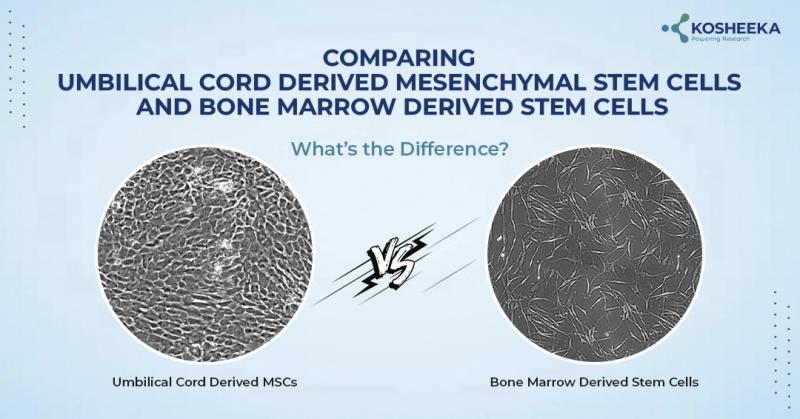Comparing Umbilical Cord Derived Mesenchymal Stem Cells and Bone Marrow Derived Stem Cells

You have probably heard all the buzz about stem cell therapy, huh? This therapy is totally trending right now. Scientists, doctors, and patients are all on the hunt for fresh options. There are two types of mesenchymal stem cells that everyone is talking about. So, we got Umbilical Cord-Derived Mesenchymal Stem Cells and Bone Marrow-Derived Stem Cells. They're super interesting. Promising results for treating diseases and injuries. Although both offer significant promise, they have unique characteristics and potential applications. But they serve different roles in medical research.
An Overview of These Stem Cells
Before diving into their specifics, here’s a brief look at the two:
Umbilical Cord-Derived Mesenchymal Stem Cells (UC-MSCs) come from Wharton's jelly, a substance found in umbilical cords. What is interesting is for years we have been discarding these cells after childbirth. The cells the umbilical cord carries have a notable ability to multiply. But they are used in research because of the cruelty and pain free nature of collection.
Bone Marrow-Derived Stem Cells (BM-MSCs) are extracted from bone marrow, a procedure that’s more invasive. These cells have been studied and used extensively, particularly in bone marrow transplants, and are still the preferred option for treating blood-related disorders.
Now, let’s take a closer look at how they compare across various parameters.
Comparative Table: UC-MSCs vs. BM-MSCs
Role of UC-MSCs and BM-MSCs in Therapeutic Research
Umbilical Cord Derived Mesenchymal Stem Cells (UC-MSCs) in Research
UC-MSCs are super useful for regenerative medicine now. They come from umbilical cords, so it’s non-invasive. Plus, they’re seen as ethical for most uses. UC-MSCs are super promising for autoimmune diseases. Think Crohn’s, lupus, or multiple sclerosis. Their immunomodulatory properties are a game changer.
Right now, clinical trials are looking into how they might help with inflammation in people with ARDS. This is a big deal because of COVID-19. UC-MSCs are chill with the immune system. That’s why they’re great for allogeneic therapies—using donor cells to help another patient.
Bone Marrow Derived Stem Cells (BM-MSCs) in Research
BM-MSCs Usw in the therapeutics have been around for a while. They have been studied since the stem cell research was taking its first steps. These cells are used in a many areas, like hematopoietic stem cell transplants to treat leukemia and lymphoma. With years of piling up of results, BM-MSCs have been deemed great for blood disorders.
BM-MSCs are super versatile, but harvesting them is a pain. It's invasive. So, this procedure needs a needle to get bone marrow, usually from your hip. It can hurt, and you'll need some time to recover.
Applications in Treatment
Stem cells, both UC-MSCs and BM-MSCs, are already being explored or applied in the treatment of multiple conditions:
UC-MSCs: These cells are in clinical trials to treat several conditions such as Parkinson’s. Their potential to fight aging adds another dimension of curiosity. These stem cells have a paracrine effect. It means that other than the replacement and regeneration of damaged tissue, they provide favorable conditions to grow new healthy cells and tissues.
BM-MSCs: These cells other than treating blood cancers and other blood disorders are increasingly being used for other conditions. So, like, right now, they're taking stem cells from the patient and using them to treat stuff like osteoarthritis and heart issues. Pretty cool, right? New studies, along with years of research, have totally put stem cell treatments in the spotlight of regenerative medicine.
Current Outlook: Where Are We Now?
When we look at the therapeutic research using stem cells, Umbilical Cord Derived Mesenchymal Stem Cells and Bone Marrow Derived Stem Cells are leading the way. Especially the UC-MSCs are quickly becoming the preferred choice, thanks to their fast growth and reduced risk to immune rejection. They are being used more and more in cool new areas like autoimmune treatments and tissue regeneration.
At the same time, BM-MSCs are still seen as reliable, particularly for blood disorders and well-studied uses like fixing joints and regenerating the heart. With more clinical trials wrapping up, we can expect to see some seriously cool therapies coming from these two major stem cell types.
In conclusion, although UC-MSCs and BM-MSCs exhibit numerous commonalities, they diverge in their origins, the simplicity of their extraction, and their distinct applications in therapy. Both are essential in propelling the future of regenerative medicine, and continuous research is expected to expand the limits of what stem cell therapy can accomplish.

Comments